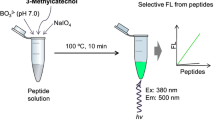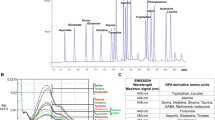Abstract
Primary amines are the target of many bioanalytical analyses, as they are ubiquitous in biological systems and responsible for numerous important processes including neurotransmission and cell signaling. Primary amines can be sensitively detected via fluorescence after their reaction with the fluorogenic reagent naphthalene-2,3-dicarboxaldehyde (NDA) in the presence of cyanide through the formation of fluorescent N-substituted 1-cyanobenz[f]isoindole (CBI) derivatives. While fluorogenic reagents such as NDA can be advantageous for sensitive detection, improvements in both long-term stability and speed of reaction are necessary to enable practical and reproducible quantitative analysis. In this work, various CBI-amines were interrogated for their fluorescence characteristics over time under previously reported conditions (75:25 aqueous buffer:acetonitrile). An amine-specific decline in fluorescence and delay to reach maximum fluorescence were observed. Based on structural characteristics, we hypothesized that these effects were due to the solvents employed enabling analyte intermolecular interactions that resulted in fluorescence quenching over time. To mitigate fluorescence-quenching intermolecular interactions, we developed two strategies to improve the fluorescence of the CBI-product over long time periods: (1) the addition of the complexation reagent β-cyclodextrin to the reaction matrix and (2) the substitution of acetonitrile with dimethyl sulfoxide. Both strategies improved fluorescence stability over time, and the incorporation of dimethyl sulfoxide also enabled more rapid attainment of maximum fluorescence and a higher absolute fluorescence when compared to initial conditions. When employed in combination, these two approaches further improve fluorescence stability over time for the most hydrophobic analytes. In the future, these strategies can be employed for the practical and reproducible quantitative analysis of primary amines in biological systems, including those related to neurological disorders and disease states.
Graphical abstract





Similar content being viewed by others
References
Nelson DL, Cox MM. Lehninger principles of biochemistry. 7th ed. New York, NY: W.H. Freeman and Company; 2017.
Waldhier MC, Gruber MA, Dettmer K, Oefner PJ. Capillary electrophoresis and column chromatography in biomedical chiral amino acid analysis. Anal Bioanal Chem. 2009;394:695–706. https://doi.org/10.1007/s00216-009-2792-y.
Harris DC, Lucy CA. Quantitative chemical analysis, 10th ed. New York, NY: Macmillian Learning; 2020.
Albin M, Weinberger R, Sapp E, Moring S. Fluorescence detection in capillary electrophoresis: evaluation of derivatizing reagents and techniques. Anal Chem. 1991;63:417–22. https://doi.org/10.1021/ac00005a006.
Wysocki LM, Lavis LD. Advances in the chemistry of small molecule fluorescent probes. Curr Opin Chem Biol. 2011;15:752–9. https://doi.org/10.1016/j.cbpa.2011.10.013.
Grimm JB, Lavis LD. Caveat fluorophore: an insiders’ guide to small-molecule fluorescent labels. Nat Methods. 2022;19:149–58. https://doi.org/10.1038/s41592-021-01338-6.
Saylor RA, Lunte SM. A review of microdialysis coupled to microchip electrophoresis for monitoring biological events. J Chromatogr A. 2015;1382:48–64. https://doi.org/10.1016/j.chroma.2014.12.086.
Shou M, Smith AD, Shackman JG, Peris J, Kennedy RT. In vivo monitoring of amino acids by microdialysis sampling with on-line derivatization by naphthalene-2,3-dicarboxyaldehyde and rapid micellar electrokinetic capillary chromatography. J Neurosci Methods. 2004;138:189–97. https://doi.org/10.1016/j.jneumeth.2004.04.006.
Nandi P, Desai DP, Lunte SM. Development of a PDMS-based microchip electrophoresis device for continuous online in vivo monitoring of microdialysis samples. Electrophoresis. 2010;31:1414–22. https://doi.org/10.1002/elps.200900612.
Chiu TC. Recent advances in on-line concentration and separation of amino acids using capillary electrophoresis. Anal Bioanal Chem. 2013;405:7919–30. https://doi.org/10.1007/s00216-013-6906-1.
Ou G, Feng X, Du W, Liu X, Liu BF. Recent advances in microchip electrophoresis for amino acid analysis. Anal Bioanal Chem. 2013;405:7907–18. https://doi.org/10.1007/s00216-013-6830-4.
Wang M, Hershey ND, Mabrouk OS, Kennedy RT. Collection, storage, and electrophoretic analysis of nanoliter microdialysis samples collected from awake animals in vivo. Anal Bioanal Chem. 2011;400:2013–23. https://doi.org/10.1007/s00216-011-4956-9.
Rammouz G, Lacroix M, Garrigues JC, Poinsot V, Couderc F. The use of naphthalene-2,3-dicarboxaldehyde for the analysis of primary amines using high-performance liquid chromatography and capillary electrophoresis. Biomed Chromatogr. 2007;21:1223–39. https://doi.org/10.1002/bmc.893.
Siri N, Lacroix M, Garrigues JC, Poinsot V, Couderc F. HPLC-fluorescence detection and MEKC-LIF detection for the study of amino acids and catecholamines labelled with naphthalene-2,3-dicarboxyaldehyde. Electrophoresis. 2006;27:4446–55. https://doi.org/10.1002/elps.200600165.
Linz TH, Lunte SM. Heat-assisted extraction for the determination of methylarginines in serum by CE. Electrophoresis. 2013;34:1693–700. https://doi.org/10.1002/elps.201200567.
Ohkura Y, Nohta H. Fluorogenic reagents for the derivatization of catecholamines and related compounds for liquid chromatographic analysis of biological samples. Trends Anal Chem. 1992;11:74–9. https://doi.org/10.1016/0165-9936(92)80081-G.
Ohkura Y, Kai M, Nohta H. Fluorogenic reactions for biomedical chromatography. J Chromatogr B Biomed Sci Appl. 1994;659:85–107. https://doi.org/10.1016/0378-4347(94)00125-1.
Carlson RG, Srinivasachar K, Givens RS, Matuszewski BK. New derivatizing agents for amino acids and peptides. 1. Facile synthesis of N-substituted l-cyanobenz[F]isoindoles and their spectroscopic properties. J Org Chem 1986;51:3978–3983. https://doi.org/10.1021/jo00371a013.
de Montigny P, Stobaugh JF, Givens RS, Carlson RG, Srinivasachar K, Sternson LA, Higuchi T. Naphthalene-2,3-dicarboxaldehyde/cyanide ion: a rationally designed fluorogenic reagent for primary amines. Anal Chem. 1987;59:1096–101. https://doi.org/10.1021/ac00135a007.
Salem N, Zuman P. Comparison of solution chemistries of orthophthalaldehyde and 2,3-naphthalenedicarboxaldehyde. Anal Chem. 2006;78:7802–8. https://doi.org/10.1021/ac061185g.
Zuman P, Salem N, Kulla E. What do we know about determination of amino acids with orthophthalaldehyde? Electroanalysis. 2009;21:645–9. https://doi.org/10.1002/elan.200804426.
Celá A, Glatz Z. Homocyclic o-dicarboxaldehydes: derivatization reagents for sensitive analysis of amino acids and related compounds by capillary and microchip electrophoresis. Electrophoresis. 2020;41:1851–69. https://doi.org/10.1002/elps.202000041.
Matuszewski BK, Givens RS, Srinivasachar K, Carlson RG, Higuchi T. N-substituted 1-cyanobenz[f]isoindole: evaluation of fluorescence efficiencies of a new fluorogenic label for primary amines and amino acids. Anal Chem. 1987;59:1102–5. https://doi.org/10.1021/ac00135a008.
Simons SSJ, Johnson DF. The structure of the fluorescent adduct formed in the reaction of o-phthalaldehyde and thiols with amines. J Am Chem Soc. 1976;98:7098–9. https://doi.org/10.1021/ja00438a070.
Simons SSJ, Johnson DF. Reaction of o-phthalaldehyde and thiols with primary amines: formation of 1-alkyl (and aryl)thio-2-alkylisoindoles. J Org Chem. 1978;43:2886–91. https://doi.org/10.1021/jo00408a030.
Stobaugh JF, Repta AJ, Sternson LA, Garren KW. Factors affecting the stability of fluorescent isoindoles derived from reaction of o-phthalaldehyde and hydroxyalkylthiols with primary amines. Anal Biochem. 1983;135:495–504. https://doi.org/10.1016/0003-2697(83)90718-2.
Nakamura H, Matsumoto A, Tamura Z. On the stability of isoindole-type fluorophores derived from o-phthalaldehyde, primary amino compounds and thiols. Anal Lett. 1982;15:1393–410. https://doi.org/10.1080/00032718208064437.
Sauvinet V, Parrot S, Benturquia N, Bravo-Moratón E, Renaud B, Denoroy L. In vivo simultaneous monitoring of γ-aminobutyric acid, glutamate, and L-aspartate using brain microdialysis and capillary electrophoresis with laser-induced fluorescence detection: analytical developments and in vitro/in vivo validations. Electrophoresis. 2003;24:3187–96. https://doi.org/10.1002/elps.200305565.
Chang PL, Chiu TC, Chang HT. Stacking, derivatization, and separation by capillary electrophoresis of amino acids from celebrospinal fluids. Electrophoresis. 2006;27:1922–31. https://doi.org/10.1002/elps.200500496.
Maddukuri N, Gong M. Vacuum-assisted electrokinetic supercharging in flow-gated capillary electrophoresis for rapid analysis of high-salt cerebrospinal fluid samples. Anal Methods. 2019;12:25–32. https://doi.org/10.1039/c9ay02143d.
Schulte S, Singh AK, Rauk E, Palmer CP. Performance and selectivity of polymeric pseudostationary phases for the electrokinetic separation of amino acid derivatives and peptides. Anal Bioanal Chem. 2005;382:777–82. https://doi.org/10.1007/s00216-005-3131-6.
Faure M, Korchane S, Le Potier I, Pallandre A, Deslouis C, Haghiri-Gosnet AM, Gamby J. Investigating of labelling and detection of transthyretin synthetic peptide derivatized with naphthalene-2,3-dicarboxaldehyde. Talanta. 2013;116:8–13. https://doi.org/10.1016/j.talanta.2013.04.060.
Herp D, Ridinger J, Robaa D, Shinsky SA, Schmidtkunz K, Yesiloglu TZ, Bayer T, Steimbach RR, Herbst-Gervasoni CJ, Merz A, Romier C, Sehr P, Gunkel N, Miller AK, Christianson DW, Oehme I, Sippl W, Jung M. First fluorescent acetylspermidine deacetylation assay for HDAC10 identifies selective inhibitors with cellular target engagement**. ChemBioChem 2022;23. https://doi.org/10.1002/cbic.202200180.
Lunte SM, Wong OS. Naphthalenedialdehyde-cyanide: a versatile fluorogenic reagent for the LC analysis of peptides and other primary amines. LC-GC. 1989;7:908–16.
Soper SA, Chamberlin S, Johnson CK, Kuwana T. Intramolecular loss of fluorescence by lysine derivatized with naphthalenedialdehyde. Appl Spectrosc. 1990;44:858–63. https://doi.org/10.1366/0003702904087172.
Manica DP, Lapos JA, Jones AD, Ewing AG. Analysis of the stability of amino acids derivatized with naphthalene-2,3-dicarboxaldehyde using high-performance liquid chromatography and mass spectrometry. Anal Biochem. 2003;322:68–78. https://doi.org/10.1016/j.ab.2003.07.002.
Parrot S, Pavón Vergés M, Perrot-Minnot MJ, Denoroy L. External influences on invertebrate brain histamine and related compounds via an automated derivatization method for capillary electrophoresis. ACS Chem Neurosci. 2017;8:1839–1846. https://doi.org/10.1021/acschemneuro.7b00025.
Zotou A, Notou M. Study of the naphthalene-2,3-dicarboxaldehyde pre-column derivatization of biogenic mono- and diamines in mixture and fluorescence-HPLC determination. Anal Bioanal Chem. 2012;403:1039–48. https://doi.org/10.1007/s00216-011-5543-9.
Denoroy L, Parrot S, Renaud L, Renaud B, Zimmer L. In-capillary derivatization and capillary electrophoresis separation of amino acid neurotransmitters from brain microdialysis samples. J Chromatogr A. 2008;1205:144–9. https://doi.org/10.1016/j.chroma.2008.07.043.
Creamer JS, Mora MF, Willis PA. Enhanced resolution of chiral amino acids with capillary electrophoresis for biosignature detection in extraterrestrial samples. Anal Chem. 2017;89:1329–37. https://doi.org/10.1021/acs.analchem.6b04338.
Chiesl TN, Chu WK, Stockton AM, Amashukeli X, Grunthaner F, Mathies RA. Enhanced amine and amino acid analysis using Pacific Blue and the Mars organic analyzer microchip capillary electrophoresis system. Anal Chem. 2009;81:2537–44. https://doi.org/10.1021/ac8023334.
NIST Chemistry WebBook, Natl. Inst. Stand. Technol. https://doi.org/10.18434/T4D303.
Zimmermann HF, John GT, Trauthwein H, Dingerdissen U, Huthmacher K. Rapid evaluation of oxygen and water permeation through microplate sealing tapes. Biotechnol Prog. 2003;19:1061–3. https://doi.org/10.1021/bp025774t.
Bos AB, Luan P, Duque JN, Reilly D, Harms PD, Wong AW. Optimization and automation of an end-to-end high throughput microscale transient protein production process. Biotechnol Bioeng. 2015;112:1832–42. https://doi.org/10.1002/bit.25601.
Szente L, Szemán J. Cyclodextrins in analytical chemistry: host-guest type molecular recognition. Anal Chem. 2013;85:8024–30. https://doi.org/10.1021/ac400639y.
Bantan-Polak T, Kassai M, Grant KB. A comparison of fluorescamine and naphthalene-2, 3-dicarboxaldehyde fluorogenic reagents for microplate-based detection of amino acids. Anal Biochem. 2001;297:128–36. https://doi.org/10.1006/abio.2001.5338.
Froehlich PM, Yeats M. The effect of mixed aqueous solvent systems on the fluorescence of indoles and aromatic amino acids and their metabolites. Anal Chim Acta. 1976;87:185–91. https://doi.org/10.1016/S0003-2670(01)83134-2.
Acknowledgements
The authors gratefully acknowledge financial support for this work from the Society for Analytical Chemists of Pittsburgh Undergraduate Analytical Research Program and Oberlin College Startup Funds.
Author information
Authors and Affiliations
Corresponding author
Ethics declarations
Conflict of interest
The authors declare no competing interests.
Additional information
Publisher's note
Springer Nature remains neutral with regard to jurisdictional claims in published maps and institutional affiliations.
Published in the topical collection Young Investigators in (Bio-)Analytical Chemistry 2023 with guest editors Zhi-Yuan Gu, Beatriz Jurado-Sánchez, Thomas H. Linz, Leandro Wang Hantao, Nongnoot Wongkaew, and Peng Wu.
Supplementary Information
Below is the link to the electronic supplementary material.
Rights and permissions
Springer Nature or its licensor (e.g. a society or other partner) holds exclusive rights to this article under a publishing agreement with the author(s) or other rightsholder(s); author self-archiving of the accepted manuscript version of this article is solely governed by the terms of such publishing agreement and applicable law.
About this article
Cite this article
Gonzalez Quevedo, P., Rigby, E.L., Kearney, S. et al. Optimized derivatization of primary amines with the fluorogenic reagent naphthalene-2,3-dicarboxaldehyde toward reproducible quantitative analysis in biological systems. Anal Bioanal Chem 415, 4297–4306 (2023). https://doi.org/10.1007/s00216-022-04508-3
Received:
Revised:
Accepted:
Published:
Issue Date:
DOI: https://doi.org/10.1007/s00216-022-04508-3




